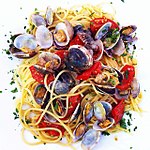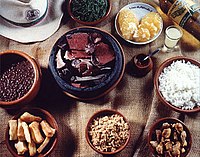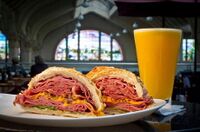Cuisine of Cartadania
This article or section is in the process of an expansion or major restructuring. You are welcome to assist in its construction by editing it as well. If this article or section has not been edited in several days, please remove this template. If you are the editor who added this template and you are actively editing, please be sure to replace this template with {{in use}} during the active editing session. Click on the link for template parameters to use.
This article was last edited by Insui (talk | contribs) 5 months ago. (Update timer) |
| This article is part of a series on the |
| Culture of Cartadania |
|---|
 |
| Society |
| Topics |
| Symbols |
|
Cartadania portal |
Cartadanian cuisine is the set of cooking practices and traditions of Cartadania, and is characterized by Levantine, Cronan, Audonian, and Alshari influences. It varies greatly by region, reflecting the country's mix of native and immigrant populations, and its continental size as well. This has created a national cuisine marked by the preservation of regional differences. Furthermore, being one of the most biodiverse countries in the world, Cartadania has one of the widest variety of available ingredients depending on the region.
The influence of Cartadania and Caphiria's spice trade in the Alshari zone, Audonia, and Crona is also notable, especially in the wide variety of spices used. These spices include chili peppers, white pepper, black pepper, saffron, paprika, clove, allspice, cumin, cinnamon, and nutmeg are used in meat, fish or multiple savoury dishes from metropolitan Cartadania, the Solemian islands, and Lotoa. Cinnamon, vanilla, lemon zest, orange zest, aniseed, clove, and allspice are used in many traditional desserts and some savoury dishes.
In spite of all of these options, due to the influence of the region, simplicity has always been a defining characteristic of Cartadanian cuisine with many chefs preparing dishes that relied less on complexity and more on quality, a trait borrowed from Caphirian cuisine. The majority of Cartadanian dishes have been created and perfected primarily by the locals rather than professional chefs, which is why many Cartadanian recipes are geared toward home and daily cooking, especially those states and regions closest to Caphiria, creating a phenomenon where only raw materials and ingredients from the region of origin of the dish are utilized in its authentic preparation.
Another staple in Cartadania is the production of sugarcane and pineapple, primarily along the coastal regions and plains. As pineapple and sugarcane plantations grew, so did demand for labor, bringing many immigrant groups to the country between 1850 and 1930. Immigrant workers brought cuisines from southern Crona, the Polynesian realm, the Istroyan islands, and Levantia after arriving in Cartadania, introducing their new foods and influencing the region.
Cuisine by region
National cuisines

The national and most widely known dish of Cartadania is moqueca, a seafood stew typically made with shrimp or fish as a base with tomatoes, onions, garlic, lime and coriander. The full meal set is the fish stew, stew of banana da terra (plantains stewed in the same manner as the fish), pirão (porridge made from cassava flour), and white rice, each one in its own clay pan.
A regional variation of this dish native to Victoria, moqueca victoriana, is considered a softer and lighter version of moqueca. Lighter oils, such as extra-virgin olive oil, are used instead of palm oil (as in the Santiagan version) and it can be made with fish, shrimp, crabs, sea crab, or lobsters. The full meal set is generally similar to the standard variation, moqueca santiaguense, served with banana da terra, pirão, and rice, each in a clay pan.
Other dishes have become quite popular but still tend to be regional staples rather than a nationally adopted dish. Caphirian dishes have seen a stark increase in popularity in recent decades with the lessening of tensions between the two countries. While Caphirian chefs have always been welcome in Cartadania, even amidst tensions, the establishment of high-end restaurants has introduced dishes from across the imperium. Relations between Cartadania and Pelaxia have always been fairly amicable, especially in comparison to other Sarpedonian nations, thus the dishes of Pelaxia have always been quite popular, especially along the border as Pelaxians have immigrated and traveled between the two nations, and vice-versa.
Valerian cuisine
Charentais cuisine

The cuisine of the Charente area is, by far, the most distinctly foreign of Cartadania's regional varieties. Influenced heavily by southeastern Levantine cuisine, the Charente is well known for its inclusion of seafood in its diet. As the most pescatarian region of Cartadania, dishes like moqueca became commonplace, though it is primarily prepared in the Victorian variation as opposed to the Santiaguense variation.
Oysters are a particularly common food in Maresia and Aleira, where they are eaten on the half shell, raw, smoked, boiled, baked, fried, roasted, stewed, canned, pickled, steamed, or broiled, while Oysters Rockefeller is the most common prepared style found in restaurants. The Charente is also the region that consumes the most wine, particularly that produced from pinot noir and chardonnay varietals.
Dishes heavily influenced by Caphirian culture fusing with the local culture include fregola com amêijoas ("fregola with clams") and the amêijoas e mexilhões panelaia ("pan-cooked clams and mussels"). Several varieties of freshly caught fish including sea bass, tuna, salmon, red snapper, mullet, anchovy, monkfish, and cod are used in the dishes of the area as well.
Lusia cuisine

In the Luson region, which includes Alexandria, Santiago, São Ricardo, Trentino, Verona, and Victoria, feijoada, a stew made with pork, beef, and beans, is popular. In Verona, a popular plate is any variation of grilled beef fillet, rice and beans, farofa, fried garlic and fried potatoes (batatas fritas). Seafood is very popular in coastal areas, as is roasted chicken (galeto). Particularly common is pão de queijo, a small, baked cheese roll. It is inexpensive, often sold from streetside stands by vendors carrying a heat-preserving container. It is also very commonly found in groceries, supermarkets, and bakeries, industrialized or freshly made.
In Alexandria, a typical dish is virado à alexandriana, made with rice, virado de feijão, sauteed kale, fried plantains or bananas, and pork chops. Alexandria is also the home of pastel, a food consisting of thin pastry envelopes wrapped around assorted fillings, then deep-fried in vegetable oil.
In Santiago, the regional dishes include corn, pork, beans, chicken (including the very typical dish frango com quiabo, or chicken with okra), tutu de feijão (puréed beans mixed with cassava flour), and local soft-ripened traditional cheeses.

In Victoria, there is significant Caphirian and western Levantine influence in local dishes, both savory and sweet. The state dish, though, is Moqueca victoriana, similar in composition to the Santiaguense variety, though lighter oils such as extra-virgin olive oil, are used instead of palm oil. Seafood dishes, in general, are very popular in Victoria as well, but unlike dishes in neighboring states, the use of olive oil is almost mandatory.
The cuisine of Trentino is a fusion of Santiago and older Verona dishes, while São Ricardo has a cuisine influenced by that of the Charente and Alexandria while also maintaining older dishes of the Fortuna era. Ricardense food has a reputation for being very spicy, but it has a wide range of flavors and while many spices are used for cooking, not all are spicy. Dishes here are typically defined by their sauces and the chiles those sauces contain (which are usually very spicy), rather than the meat or vegetable that the sauce covers. As a result, it is sometimes separated out from the Luson cuisine, though the majority of its dishes share a common style and mixture with other Luson states.
Etracian cuisine

When Cartadanians began migrating more into the Etracian zone, they found much of the land in the area was suitable for raising cattle, goats, and sheep. This led to the dominance of meat, especially beef, in the region, and some of the most popular dishes incorporate one or more of these meats.
The ranch culture of this area has also prompted cheese production, thus dishes in this area also tend to use various types within dishes. It is in the Etracian that native pasta dishes with large amounts of cheese originated, such as Queijo e pimenta. In keeping with its name, the dish contains grated cheese and black pepper, together with spaghetti, or traditionally tonnarelli. This dish is heavily based on Caphirian cuisine standards, a trend that is particularly common in this region.
Baía Sul cuisine
Saçilha cuisine

The Saçilha region's cuisine, based in the states of Alta Roma and Baixa Roma, is the overall closest to traditionally Caphirian cuisine in Cartadania. Here, tomatoes (fresh or reduced to tomato sauce), peppers, olives and olive oil, garlic, artichokes, oranges, ricotta cheese, eggplants, zucchini, certain types of fish (anchovies, sardines, and tuna), and capers are essential components to the local cuisine. Pasta-based dishes are quite common, and as a border region, the cuisine is heavily reflective of and based upon that of Ranaella. In the metropolitan cuisine, pasta is prepared in various styles that can feature tomato sauce, cheese, clams, and shellfish.
This region extensively produces tomatoes, peppers, spring onions, potatoes, artichokes, fennel, lemons, and oranges which all take on the flavor of volcanic soil, especially those produced in Baixa Roma.
Satherian cuisine
Satheria's cuisine, based in the states of Loumara, Miraflores, and Vitrea, is one based heavily on localized availability. Due to the abundance of forest and freshwater rivers in the area, fish, fruits, and cassava (including flours made of cassava) are staple foods. Although many animal species are hunted for food in the biologically diverse jungle, standouts are the paiche (one of the world's largest freshwater fish), prepared in variety of dishes. The black caiman is also considered part of the cuisine in this area. The large numbers of the animal combined with local regulations have created a set of dishes that have become popular in many areas across the country. It has been used both historically and in contemporary times in various cuisines of the area.
Marinales cuisine

In the valleys and plains of the Valerian region, the diet is still a traditional one based on corn, potatoes, and casava. Linguiçinha, a fusional dish consisting of grilled ground meat rolls in cylindrical shape made from a mixture of beef, lamb with spices, such as garlic, black pepper, thyme, coriander, anise, savory, and sometimes a touch of paprika, originates in São Andreas.
Triessa's coastline has a cuisine more akin to the Luson cuisine, especially Valorica, while its interior is more Valerian in nature. Coxinha, a popular food consisting of chopped or shredded chicken meat, covered in dough, molded into a shape resembling a drumstick, battered and fried, originates in the state. Also popular in the state is the Mortadella sandwich, which is very popular throughout Cartadania especially Valorica. The sandwich is made from nearly a half a pound of mortadella sausage, Provolone cheese, sourdough bread, mayonnaise, and Dijon mustard.
Taínean cuisine
Drinks
Cachaça is Cartadania's native liquor, distilled from sugar cane and it is the main ingredient in the national drink, the Caipirinha, a cocktail prepared using cachaça, lime juice and sugar. Other drinks include mate tea, chimarrão and tereré (both made up of yerba maté), coffee, fruit juice, beer (mainly Pilsen variety), rum, guaraná and batidas. Guaraná is a caffeinated soft drink made from guaraná seeds and batida is a type of fruit punch.
Coffee's extreme popularity in Cartadania reaches all ages and demographics. One of the most popular drinks of the country is café com leite, which is an extremely strong coffee blended with a large amount of milk. This drink is usually served at breakfast to adults and children alike. Similarly, another popular drink is the cafezinho, made with a strong coffee blend similar to that used in café com leite and a large portion of sugar. The main coffee port in Cartadania is Newport, where there is also a lot of coffee processing industry. Santiago is also the nations largest producer of coffee, thus, a lot of the processing happens throughout the state.
Desserts

Desserts in Cartadania come in various forms, but most popular are bolo de rolo, brigadeiro, and beijinho. Bolo de rolo is a cake dish originating from the Luson region, the cake batter of which is made with flour, eggs, butter and sugar. This dough is wrapped with a layer of guava paste, giving the appearance of a swiss roll with much thinner layers. The brigadeiro and beijinho have similar preparations, but while the brigadeiro is made of condensed milk, cocoa powder, butter, and chocolate sprinkles covering the outside layer, the beijinho is prepared with condensed milk, grated desiccated coconut, rolled over caster sugar or grated coconut and frequently topped with a clove.
Another dish particularly popular is Açaí na tigela, which is a dish made with the frozen and mashed fruit of the açaí palm, which has berries described as having an "earthy" or creamy taste. Its texture is granular before blending and it has a tartness from a high acidity content, making its taste appealing. It is served as a smoothie in a bowl or glass, and is commonly topped with granola and banana, and then mixed with other fruits and guaraná syrup.
Dulce de leche is a dish adopted from Pelaxia which has grown in popularity throughout the years following independence and is often sold by grocery stores, supermarkets, and confectioners.
Meal structure
See also